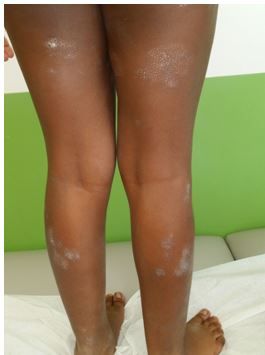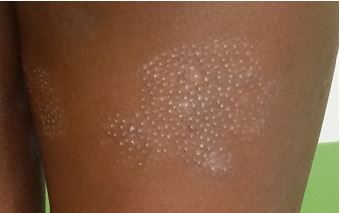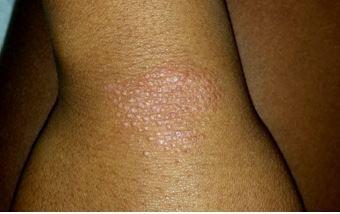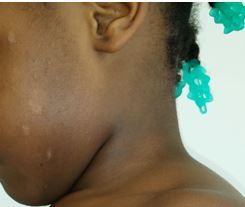Lichen Spinulosus in a Young Girl
Lichen spinulosus is a rare, hyperkeratotic dermatosis similar to keratosis pilaris. It is most common in children, adolescents, young adults with male predominance. Treatment includes keratolytics and emollients.
Figure 1. Note excoriations at upper left.

Figure 2.

Figure 3. 3-week-old lesion over the wrist.

Figure 4. 2-week-old lesions on the face.

A 7-year-old girl with a 2-year history of moderately pruritic lesions on the trunk and extremities, presented with new lesions on the hands and face. When the lesions first developed two years earlier, she was diagnosed with nummular eczema and prescribed triamcinolone 0.1%; this provided mild relief from the pruritus but left the lesions otherwise unchanged. For the next year, she was seen numerous times for the same complaint, and was treated with clotrimazone 1% for possible tinea corporis and again with topical steroids for eczema. Lesions persisted and the patient was lost to follow-up until new lesions started cropping up on her hands and face, prompting another visit. The child is otherwise healthy and there is no known family history of heritable dermatologic conditions.
Physical examination revealed multiple spinous punctate papules grouped into dry, rough hypopigmented patches ranging from 1 to 4 centimeters in diameter (Figures 1 and 2). These were located mostly on the arms and legs with a few scattered on the back and abdomen; some had overlying excoriations. The new lesions on the hands and face (Figures 3 and 4) were less rough and scaly, and were flatter and less spinous.
What is the cause of this dermatologic condition?
A. Atopic dermatitis
B. Keratosis pilaris
C. Lichen spinulosus
D. Lichen planus
Answer: C. Lichen spinulosus
Discussion
Lichen spinulosus (LS) is a rare, hyperkeratotic dermatosis similar to keratosis pilaris. Typical lesions consist of follicular keratotic papules with spinous projections, grouped into large patches usually involving the neck, buttocks, abdomen, trochanteric regions, knees, and extensor surfaces of the arms. They can appear simultaneously or in crops, and may be mildly pruritic. Palpation yields a “nutmeg-grater sensation” due to the spiny nature of the papules. Some clinicians have considered lichen spinulosus as a variant of keratosis pilaris, and although the two are histologically similar, there are clinical differences. Keratosis pilaris occurs more frequently, and distribution is generally more diffuse compared to the discrete groups of lesions found in lichen spinulosus. Lesions in lichen spinulosus also have a predisposition for acral areas, whereas keratosis pilaris lesions are frequently limited to the upper arms and legs. Lichen spinulosus does not vary with the seasons.1,2
Lichen spinulosus is more commonly seen in children and adolescents, up to young adulthood, with male predominance. Occurrences in the elderly, although rare, have been reported.3 No definitive cause has been identified, although a genetic component for the disease has been suggested.1 Some authors report an association with atopy.4,5 Lichen spinulosus or lichen spinulosus-like eruptions have been observed after exposure to thallium, gold, diphtheria toxin, and arsphenamine;1 and in association with underlying systemic diseases eg, Hodgkin disease,2 HIV,6 Crohn disease,7 and alcoholism.3 Vitamin A deficiency has also been implicated in the pathogenesis of LS.2 Kabashima, et al described improvement in lesions in an alcoholic patient after abstinence from alcohol and nutritional management with vitamin supplementation.3 Some authors have proposed that lichen spinulosus may represent a follicular reaction to various agents including infection, toxins, chemicals, and drugs.2 Others suggest a possible exaggerated immunological response to hair-follicular organisms such as pityrosporum.3
Treatment of lichen spinulosus includes keratolytics and emollients. Improvement has been reported with the use of topical salicylic acid gel with and without occlusion (for 2 weeks and 8 weeks, respectively). Other treatment options like propylene glycol, tar preparations, midpotency topical corticosteroids, ammonium lactate lotions, topical vitamin A,1and tretinoin gel 0.04%5 are associated with variable degrees of improvement. In those in whom the dermatosis is associated with an underlying systemic illness, management of the systemic disease may result in improvement in the lesions.3 Most patients exhibit no other concerning symptoms and may be left untreated. The natural course of lichen spinulosus is variable; lesions may resolve spontaneously, persist unchanged for months or years, or have a relapsing-remitting course.1,8
In our case, the diagnosis was made clinically and the patient was given a trial of topical 17% salicylic acid together with emollients. On a follow-up call, the child’s mother reported that although the lesions have persisted, some of them have become less rough.
References:
1. Tilly JJ, Drolet BA, Esterly NB, Lichenoid eruptions in children. J Am Acad Dermatol. 2004;51:606-624.
2. Friedman, SJ. Lichen spinulosus: clinicopathologic review of thirty-five cases. J Am AcadDermatol. 1990;22(2 Pt 1):261-264.
3. Kabashima, R, Sugita K, Kabashima K, Nakamura M, Tokura Y. Lichen spinulosus in an alcoholic patient. Acta Derm Venereol. 2009;89:311-312.
4. Boyd AS. Lichen spinulosus: case report and overview. Cutis. 1989;43:557-560.
5. Forman SB, Hudgins EM, Blaylock WK. Lichen spinulosus: excellent response to tretinoin gel and hydroactive adhesive applications. Arch Dermatol. 2007;143: 122-123.
6. Cohen SJ, Dicken CH. Generalized lichen spinulosus in an HIV-positive man. J Am Acad Dermatol. 1991;25(1 Pt 1):116-118.
7. Kano Y, Orihara M, Yagita A, Shiohara T. Lichen spinulosus in a patient with Crohn's disease. Int J Dermatol. 1995;34:670-671.
8. Venkatesh A, Dupuis E, Prajapati V, Rao J. Generalized lichen spinulosus in a 4-year-old boy without systemic disease. Arch Dermatol. 2012;148:865-866.